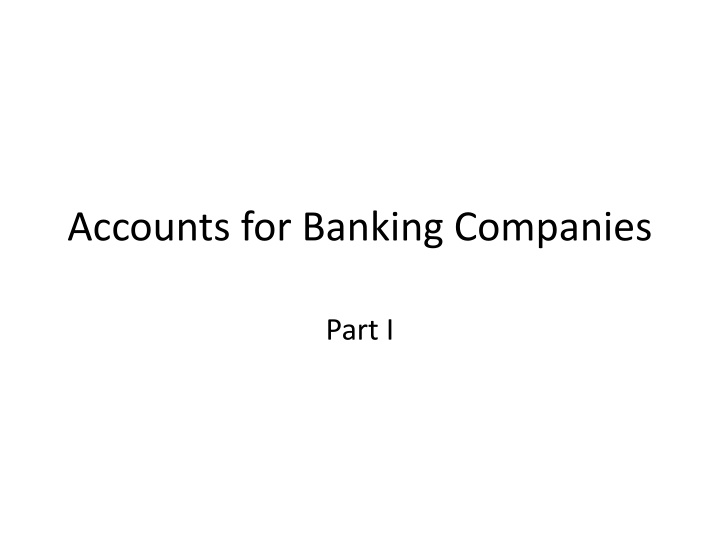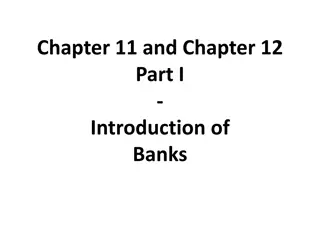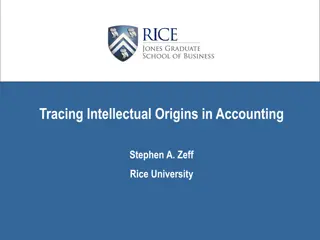
Banking Regulations in India: Part I
Explore the key aspects of banking regulations in India, including the meaning of banking companies, principal provisions of the Banking Regulation Act, management requirements, and minimum capital reserves. Gain insights into the framework governing banking operations in the country.
Download Presentation

Please find below an Image/Link to download the presentation.
The content on the website is provided AS IS for your information and personal use only. It may not be sold, licensed, or shared on other websites without obtaining consent from the author. If you encounter any issues during the download, it is possible that the publisher has removed the file from their server.
You are allowed to download the files provided on this website for personal or commercial use, subject to the condition that they are used lawfully. All files are the property of their respective owners.
The content on the website is provided AS IS for your information and personal use only. It may not be sold, licensed, or shared on other websites without obtaining consent from the author.
E N D
Presentation Transcript
1.2 MEANING OF BANKING COMPANY According to Sec. 5 of the Banking Regulation Act, 1949, a banking company means the accepting, for the purpose of lending or investment, of deposits of money from the public, repayable on demand or otherwise and withdrawn by Cheque, Draft, Order or otherwise. In short, a banking company means and includes any company which carries on the business or which transacts the business of banking in India.
1.3 PRINCIPAL PROVISIONS OF BANKING REGULATION ACT Section 8 to 34
Disposal of Non Banking Assets Section 9
Management (Sec. 10): Sec. 10(a) states that not less than 51% of the total number of members of the Board of Directors of a banking company shall consist of persons who have special knowledge or practical experience in one or more of the following fields: (a) Accountancy; (b) Agriculture and Rural Economy; (c) Banking; (d) Co-operation; (e) Economics; (f) Finance; (g) Law and (h) Small- scale Industry
Minimum Capital Reserves (Sec. 11): Sec.11 of the Banking Regulation Act, 1949, provides that no banking commence or carry on business in India, unless it has minimum paid-up capital and reserve of such aggregate value as noted below company shall
(a) Foreign Banking Companies In case of banking company incorporated outside India, its paid-up capital and reserve shall not be less than ` 1 lakh in respect of its principal place of business plus ` 15 lakhs and, if it has a place of business in Mumbai or Kolkata or in both, ` 20 lakhs.
(b) Indian Banking Companies: In case of an Indian banking company, the sum of its paid-up capital and reserves shall not be less than the amount stated below: (i) If it has places of business in more than one State, ` 5 lakhs, and if any such place of business is in Mumbai or Kolkata or in both, ` 1 lakh in respect of its principal place of business plus ` 10 lakhs.
Regulation relating to Capital Section 12
Payment of Commission, Brokerage etc. (Sec. 13): According to Sec. 13, a banking company is not permitted to pay directly or indirectly by way of commission, brokerage, remuneration on issues of its shares in excess of 2 of the paid-up value of such shares. discount or
Payment of Dividend (Sec. 15): According to Sec. 15, no banking company shall pay any dividend on its shares until all its capital expense (including preliminary organization expenses, commission, brokerage, incurred and other items of expenditure not represented by tangible assets) have been completely written off. expenses, selling of losses share amount
Reserve Fund/Statutory Reserve (Sec. 17) According to Sec. 17, every banking company incorporated in India shall, before declaring a dividend, transfer a sum equal to 20% of the net profits of each year (as disclosed by its Profit and Loss Account) to a reserve fund. The Central Government may, recommendation of RBI, exempt it from this requirement for a specified period. however, on the
Sec 17 cont. The exemption is granted if its existing reserve fund together with Share Premium Account is not less than its paid-up appropriates any sum from the reserve fund or the share premium account, it shall, within 12 days from the date of such appropriation, report the fact to the Reserve Bank, explaining the circumstances relating to such appropriation capital. If it
Cash Reserve (Sec. 18): Under Sec. 18, every banking company (not being a Scheduled Bank) shall, if Indian, maintain in India, by way of a cash reserve in cash, with itself or in current account with the Reserve Bank or the State Bank of India or any other bank notified by the Central Government in this behalf, a sum equal to at least 3% of its time and demand liabilities in India.
(Sec. 18 cont.) The Reserve Bank has the power to regulate the percentage also between 3% and 15% (in case of Scheduled Banks). Besides the above, they are to maintain a minimum of 25% of its total time and demand liabilities unencumbered approved securities. But every banking company s asset in India should not be less than 75% of its time and demand liabilities in India at the close of last Friday of every quarter. in cash, gold or
Liquidity Norms (Sec. 24) According to Sec. 24 of the Act, banking companies must maintain sufficient liquid assets in the normal course of business. The section states that every banking company has to maintain in cash, gold or unencumbered approved securities, an amount not less than 20% of its demand and time liabilities in India. This percentage may be changed by the RBI from time to time according circumstances of the country. This is in addition to the average daily balance maintained by a bank. to economic
Accounts and Audit (Secs. 29 to 34A): The above Sections of the Banking Regulation Act deal with the accounts at audit. Every banking company, incorporated in India, at the end of financial year expiring a period of 12 months as the Central Government may by notification in the Official Gazette specified, must prepare a Balance Sheet and a Profit and Loss Account as on the last working day of that year or according to the Third Schedule or as circumstances permit.
Format of Balance Sheet of a Banking Co. Company Balance Sheet of ________________________ (here enter name of the banking group) FORM OF CONSOLIDATED BALANCE SHEET OF A BANK AND ITS SUBSIDIARIES ENGAGED IN FINANCIAL ACTIVITIES (000 s omitted) Balance Sheetas on March 31 (Year) as on March 31 (Year) (current year) as on March 31 (Year) (previous year) Schedule CAPITAL & LIABILITIES Capital Reserves & Surplus Minorities Interest 2A Deposits Borrowings Sundry Payables Other Liabilities and Provisions Total ASSETS Cash and Balances with Reserve Bank of India 1 2 2A 3 4 5 6 Balances with banks and money at call and short notice 7 8 9 Investments Loans & Advances Sundry Receivables Fixed Assets Other Assets Goodwill on Consolidation Debit Balance of Profit and Loss A/C Total Contingent liabilities Bills for collection 10 11 12
Format of P & L Accounts of a Banking Co. FORM OF CONSOLIDATED PROFIT & LOSS ACCOUNTS OF A BANK AND ITS SUBSIDIARIES ENGAGED IN FINANCIAL ACTIVITIES Profit & Loss Accounts________________________ (here enter name of the banking group) (000 s omitted) Profit & Loss Accounts for the year ended March 31 ___ as on March 31 (Year) (current year) as on March 31 (Year) (previous year) Schedule I. Income Interest and dividend earned1 Share of earnings in Associates Other income Total II. Expenditure Interest expended Operating expenses Provisions and contingencies Total Consolidated Net profit/(loss) for the year before deducting Minorities' Interest Less: Minorities' Interest Consolidated profit/(loss) for the year attributable to the group Add: Brought forward consolidated profit/(loss) attributable to the group III. Appropriations Transfer to statutory reserves Transfer to other reserves Transfer to Government/Proposed dividend Balance carried over to consolidated balance sheet Total Earnings per Share 13 14 15 16






















